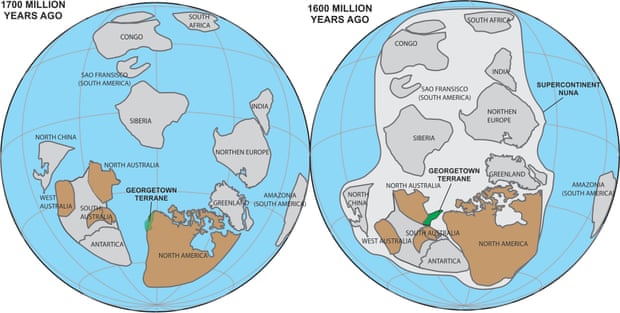Georgetown in northern Queensland once part of North America

Researchers found rocks in the area 412km west of Cairns were unlike any others in Australia, but similar to those in Canada
 The Georgetown terrane of present-day northern Queensland
The Georgetown terrane of present-day northern Queensland
was originally part of North America some 1,7bn years ago.
Deakin University
Geologists in northern Australia have made a discovery that suggests the area around Georgetown in northern Queensland was once part of North America, more than a billion years ago.
Researchers from Curtin University discovered that rocks in the area, 412km west of Cairns, were unlike any other rock deposits in Australia, but similar to those found in Canada.
This means that the Georgetown area – with a current population of roughly 250 – was originally a part of North America, and only collided with the rest of the Australian land mass during the formation of the ancient supercontinent Nuna (also known as Columbia) 1.7bn years ago.
 A graphic showing how part of Queensland was attached to North America
A graphic showing how part of Queensland was attached to North America
as part of the supercontinent Nuna.
Curtin University
Nuna predates the supercontinent Pangea by 1.3bn years, and was formed as part of what geologists describe as the supercontinent cycle – where tectonic movements over Earth’s history have repeatedly created and destroyed supercontinents.
Pangea, a relatively recent supercontinent, is believed to have formed 335m years ago and began breaking apart 175m years ago. Nuna is believed to have formed 1.7bn years ago, and to have broken apart after 100m years.
Based on the Georgetown discovery, researchers now believe that the whole of northern Queensland was a part of North America that collided with Australia when Nuna formed. When the supercontinent drifted apart, it broke off and stuck to Australia.
The lead researcher, Adam Nordsvan, said the Georgetown area likely collided with the Mount Isa region of Queensland.
 Rock near Georgetown was found to be not like any other rock in Australia
Rock near Georgetown was found to be not like any other rock in Australia
but closely related to rock in North America.
Curtin University
“We found that in Mount Isa the rocks were very typically Australian,” he told Guardian Australia. “We can tie them to other parts of Australia. Surprisingly, in Georgetown – about 500km away – we found signatures that were completely unknown to the Australian continent, and are remarkably similar to North America.”
He said preliminary data suggested the whole of northern Queensland above Georgetown could have been part of North America at the time.
“We are expecting more data this year that will definitely show whether or not they are the same, but it is likely that the whole northern tip of Queensland is North American. That’s one of the implications of the paper.”
He said that links between Australia and North America had first been proposed in the late 1970s, and further researched in the early 1990s. In models of other supercontinents, such as Rodinia (formed after the breakup of Nuna), eastern Australia has been connected by geologists to the west of North America.
“On the North American side, some great research has come out showing the connection was likely at that time [of Nuna],” Nordsvan said. “In Australia there has been a little bit of research that shows the connection was likely there. This is probably the first piece of really good evidence that at 1.7bn or 1.6bn years ago, there was definitely a connection between the two continents.”
The paper was co-authored by researchers from Monash University and the Geological Survey of Queensland, and was published in the journal Geology.
=============================
by Naaman Zhou
There may be links in the Original Article that have not been reproduced here.


Geological time is so very hard to apprehend...
... almost as hard as billionaire wealth...